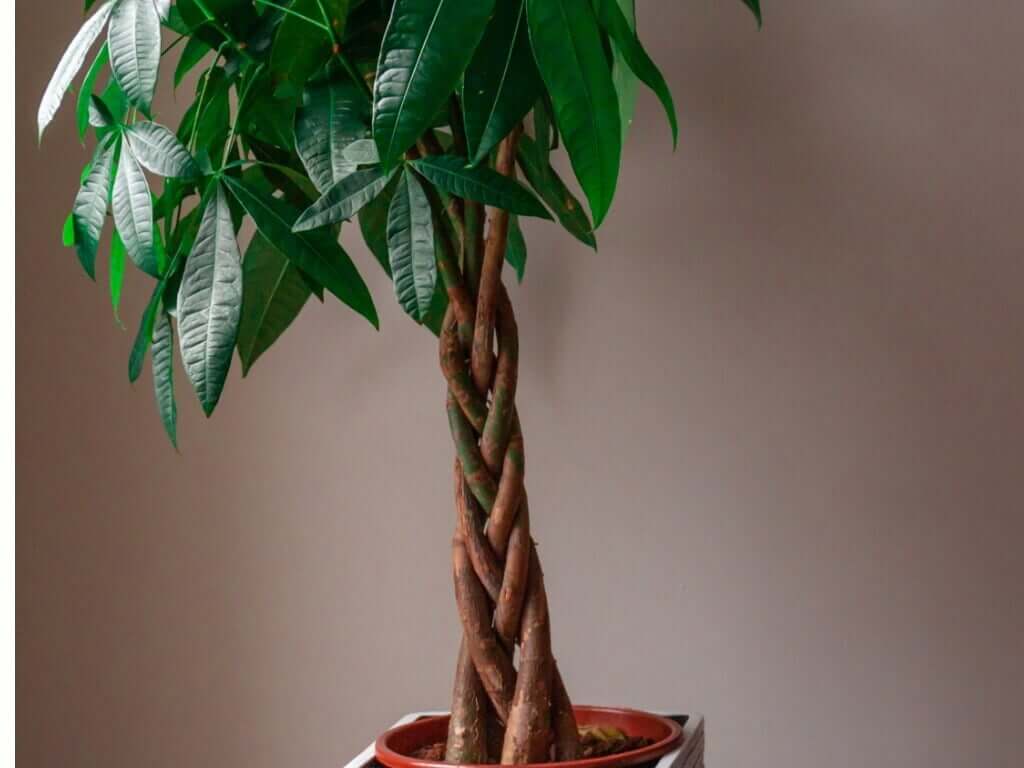The Money Tree is a popular indoor plant and is familiar to most people as the houseplant with a braided trunk.
This ornamental plant is a good addition to your plant collection, whether indoors or outdoors.

The Basics of Money Tree
The money tree or money plant is Pachira aquatica.
This money tree should not be confused with the other plant with the same nickname: Crassula ovata or Jade Plant.
Money tree is also known as Guiana chestnut, French peanut, Malabar chestnut, Provision tree, Monguba, Saba Nut, and Pumpo.
It is commercially sold as Money tree and Money plant due to its popularity in Asia as symbolic of good financial fortune.
While it is most commonly known as an indoor plant, Pachira aquatica can naturally grow to almost 60 feet (about 18 metres) high.
Indoor or container-planted money trees only grow to a maximum height of about 6 feet (182 cm).
The leaves of the money tree are shiny green, palmate, and lance-shaped. There can be up to nine (9) leaflets or fingers and grow to about 11 inches (28 cm) long.
When young, the trunks of the money tree are green and pliable, which is when the trunks are braided together. Once the money tree matures, the trunks harden and turn brown and woody.
Planting Your Money Tree
Money trees can be propagated through seeds or cuttings.
Summer is the best time to take cuttings for propagating money tree.
To get stem cuttings for your money tree, cut about 4 to 6 inches (10 to 15 cm).
You can use water or potting soil to root the money tree cutting. You may also use rooting hormones to ensure success in rooting the money tree cuttings.
When rooting cuttings in water, make sure that the water is about 1 inch (2.5 cm) deep, and place the cutting in a warm and bright place.
Once the cuttings produce roots, you can plant your money tree in a container.
Choose a rich and well-draining medium to plant your money tree.
Water your growing money plant but take care not to wet the stems and leaves.
This tropical plant prefers moist and frost-free areas and will adapt well to different conditions.
Transplant your money tree to a bigger container when it gets larger to allow it to grow more.


Caring for Your Money Tree
Position and Temperature
The money tree will do well in temperatures between 32 to 77 °F (12 to 25 °C), although it can tolerate temperatures down to 41 °F (5 °C).
If you live in a place with really cold winters, it is best to take your money tree indoors if you have placed them outside.
Money trees also prefer humid environments.
If your area is too dry, place some water in a shallow container close to your plant. This will help increase the humidity around your money tree.
Choose for your money tree a position that is bright but away from direct sunlight.
Water
Wait until the soil is dry before watering your money tree.
However, take care not to leave it dry for too long. Water as soon as the top 1 to 2 inches (2.5 to 5 cm) of the soil is dry.
Water your money tree at the base, taking care not to wet the trunk and leaves.
Fertiliser
Bonsai money trees need feeding about two to three times a year, while full-grown money plants or trees need more.
Fertilise your money tree every two weeks during spring and summer using a diluted liquid fertiliser.
Remember that no plant can tolerate too much fertiliser, so less is better than giving your money tree too much.
Pruning
Keep your money tree healthy by being on top of removing dead leaves as soon as you see them.
Prune in spring or summer if you are pruning your money tree to shape.
Keep It Clean
Keep the leaves of your money tree clean and dust free by wiping the leaves with a clean and damp cloth.
Dirt build-up on the leaves could weaken your plant as the money tree will not be able to absorb light, air, and moisture efficiently.
Dusty leaves will also make your indoor money tree inefficient in helping clean the air in your home.


Common Problems with Money Tree
If you are on top of cleaning and taking care of your money tree, it will unlikely be infested with pests or infected with diseases.
However, some money trees can still get diseases such as leaf spots and root rot.
Leaf spots could be a nutrient deficiency, especially potassium. Find a fertiliser high in this nutrient and feed it to your money tree.
Over-watering causes many issues in money trees, including leaf spots, root rot, and mould in the substrate.
Make sure to keep your money tree well-drained and avoid over-watering.
The most common garden and indoor plant pests are aphids, spider mites, and scales.
These pests can be avoided by keeping your money tree clean.
If the infestation cannot be avoided, treat these pests with neem oil or pesticides formulated as safe for money trees.
[elementor-template id=”4604″]
[elementor-template id=”6387″]
